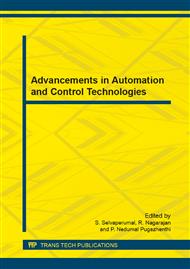[1]
C. Parampalli, R. Sekar, and R. Johnson, A Practical Mimicry Attack against Powerful System-Call Monitors, Proc. ACM Symp. Information, Computer, and Comm. Security, pp.156-167, (2008).
DOI: 10.1145/1368310.1368334
Google Scholar
[2]
Atul Singh, NishantSinha, NitinAgrawal, AVATARs for Pennies: Cheap N-version Programming for Replication", USENIX Sixth Workshop on Hot Topics in System Dependability (HotDep , 10), Oct 2010, Vancouver, BC, Canada.
Google Scholar
[3]
G. Kc, A. Keromytis, and V. Prevelakis, Countering Code-Injection Attacks with Instruction-Set Randomization, Proc. ACM Conf. Computer and Comm. Security, pp.272-280, (2003).
DOI: 10.1145/948109.948146
Google Scholar
[4]
Thomas C. Bressoud, Fred B. Schneider. Hypervisor-Based Fault-Tolerance, ACM Transactions on Computer Systems, Vol. 14, No. 1, February 1996, Pages 80-107.
DOI: 10.1145/225535.225538
Google Scholar
[5]
Jun Zhu, Wei Dong, Zhefu Jiang, Xiaogang Shi, Zhen Xiao, Xiaoming Li, Improving the Performance of Hypervisor-Based Fault-Tolerance.
Google Scholar
[6]
B. Salamat, A. Gal, T. Jackson, K. Manivannan, G. Wagner, and M. Franz, Multi-Variant Program Execution: Using Multi-Core Systems to Defuse Buffer-Overflow Vulnerabilities, " Proc. Int, l Conf. Complex, Intelligent, and Software Intensive Systems, pp.843-848, Mar. (2008).
DOI: 10.1109/cisis.2008.136
Google Scholar
[7]
Benjamin Cox, David Evans, Adrian Filipi, Jonathan Rowanhill, Wei Hu, Jack Davidson, John Knight, Anh Nguyen-Tuong, and Jason Hiser, N-Variant Systems A Secretless Framework for Security through Diversity, 15th USENIX Security Symposium, Vancouver, BC, August (2006).
DOI: 10.1145/1134760.1134764
Google Scholar
[8]
Liming CHEN, AlgirdasAVlZlENlS, N-Version Programming: A Fault-Tolerance Approach To Reliability Of Software Operation, 1996 IEEE Proceedings of FTCS-25, Volume 111.
Google Scholar
[9]
Todd Jackson, BabakSalamat, Gregor Wagner, Christian Wimmer, Michael Franz, On the Effectiveness of Multi-Variant Program Execution for Vulnerability Detection and Prevention, MetriSec2010, September 15, 2010, Bolzano-Bozen, Italy.
DOI: 10.1145/1853919.1853929
Google Scholar
[10]
A. Avizienis and L. Chen. On the implementation of n-version programming for software fault tolerance during execution,. In Proceedings of the International Computer Software and Applications Conference, pages 149–155. IEEE Computer Society, (1977).
Google Scholar
[11]
B. Salamat, T. Jackson, A. Gal, and M. Franz, Orchestra: Intrusion Detection Using Parallel Execution and Monitoring of Program Variants in User-Space, Proc. European Conf. Computer Systems, pp.33-46, (2009).
DOI: 10.1145/1519065.1519071
Google Scholar
[12]
E. Barrantes, D. Ackley, T. Palmer, D. Stefanovic, and D. Zovi. Randomized instruction set emulation to disrupt binary code injection attacks,. In Proceedings of the ACM Conference on Computer and Communications Security, pages 281–289. ACM Press, (2003).
DOI: 10.1145/948109.948147
Google Scholar
[13]
K. Birman. Replication and fault-tolerance in the ISIS system,. ACM SIGOPS Operating Systems Review, 19(5): 79–86, (1985).
DOI: 10.1145/323627.323636
Google Scholar
[14]
BabakSalamat, Todd Jackson, Gregor Wagner, Christian Wimmer, and Michel Franz, Runtime Defense against Code Injection Attacks Using Replicated Execution, Senior Member, IEEE, on IEEE Transactions On Dependable And Secure Computing, Vol. 8, No. 4, July/August2011.
DOI: 10.1109/tdsc.2011.18
Google Scholar
[15]
B. Salamat, C. Wimmer, and M. Franz, Synchronous Signal Delivery in a Multi-Variant Intrusion Detection System, technical report, School of Information and Computer Sciences, Univ. of California, (2009).
Google Scholar
[16]
Algirdas A. Avizienis, The Methodology Of N-Version Programming, Software Fault Tolerance, 1995 John Wiley & Sons Ltd.
Google Scholar
[17]
A. Avizienis. The n-version approach to fault-tolerant software". IEEE Transactions on Software Engineering, SE-11(12): 1491–1501, 1985. D. Black, C. Low, and S.K. Shrivastava, "The Voltan Application Programming Environment for Fail-Silent Processes, Distributed Systems Eng., vol. 5, pp.66-77, (1998).
DOI: 10.1109/tse.1985.231893
Google Scholar


